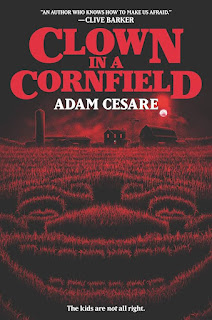Town mascot turned madman: young adult slasher tale with political underpinnings explores the battle between tradition and change.
Have you ever been in a situation where you thought older people weren’t listening to you? Of course you have. What about a scenario where younger people push for a change you don’t want? Admit it: you’ve been there as well. These are the issues at play in Adam Cesare’s Clown in a Cornfield, though the stakes are likely much higher than you’ve ever encountered.
When financial hardship hits, Dr Glenn Maybrook and his teenage daughter Quinn move from Philadelphia to Kettle Springs, Missouri. Here, elders view teens as a threat to their rural town’s hallowed traditions, and teens suspect adults are trying to impose their values on them.
Quinn soon meets Cole Hill, a charismatic quarterback. You know the type: attractive, confident, admired by his peers yet haunted by his past. She gets involved in Cole’s group of ne’er-do-wells: Janet, Ronnie (who clearly likes Cole), the bodyguard-like Tucker, and the beer-swigging party boy Matt. Power-hungry Sheriff George Dunne, resenting the changes happening under his watch, has his sights set on the teens.
Overshadowing all of this is Frendo, the unofficial town mascot invented by Cole’s grandfather. Initially, the only evidence of Frendo that Quinn sees is the faded painting of the clown on a burned-down factory across the cornfield next to her house. But Frendo will make more appearances, and not all Frendos in Kettle Springs are kid friendly.
Though there’s nothing groundbreaking about this young adult horror story in which characters gradually get picked off by someone or something, it zips along and keeps the reader engaged. The over-the-top weaponry (e.g., chainsaw, circular saw, machete) fits the typical slasher fare.
Not only does Cesare defend the voice of young people, but he also combats the notion that heroines need to be rescued by a male figure. Quinn Maybrook is a strong, thoughtful, and brave young woman not prone to swooning at the slightest threat. Cesare also explores the complexities of Quinn’s relationship with her father and how her mother’s drug problem complicated their lives.
At its core, the novel advocates for youth-inspired change, which is nothing to clown around about.—Douglas J. Ogurek***


No comments:
Post a Comment